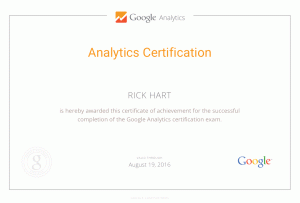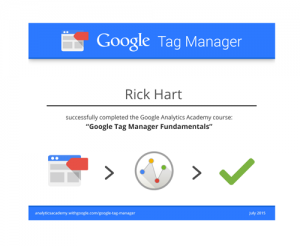 There’s a well-known marketing axiom that says “you can’t manage what you don’t measure.” And most marketing is pretty hard to measure. Can you really tell if your billboard or newspaper ad or TV commercial brings in new customers? It’s difficult to know for sure.
There’s a well-known marketing axiom that says “you can’t manage what you don’t measure.” And most marketing is pretty hard to measure. Can you really tell if your billboard or newspaper ad or TV commercial brings in new customers? It’s difficult to know for sure.
But with online marketing just about everything is trackable. You can easily find out where your site’s visitors came from, what they did while they were on your site, and whether they took a particular action you desired. That’s one of the advantages of online marketing over all other types of marketing.
Google Analytics
Now the most commonly used and maybe the most powerful of the website tracking tools is a free system from Google. It’s called Google Analytics.
Google Analytics will help you know where your visitors came from, how long they stayed on your site and how many web pages they actually visited. But that’s just the beginning of what it can do.
Google Analytics has been around for many years and Google keeps making it better. There is no reason not to be using Google Analytics because it’s free and very easy to install. If you can’t do it yourself then it would be easy for your webmaster to do. And if you have a webmaster, I sure would be asking them why they hadn’t put Analytics on your site already. It’s a no-brainer that even a beginning webmaster should be utilizing. If they haven’t then maybe you might want to consider another webmaster.
You can visit the Google Analytics website to learn more here.
I’m Google Certified in Google Analytics
Once the light went on and I realized how important tracking was to Online Marketing, I made a point of becoming an expert in Google Analytics. I studied for and received by Google Certification, called a Google Analytics Individual Qualification (GAIQ), to make sure I was up-to-speed in all that Google Analytics could do. Believe me it’s a power tool! You can learn more at my Google Profile here.

Google Tag Manager
And if you are serious about using Google Analytics, or you have a lot of sites, you also want to be using Google Tag Manager. It helps you manage all your tracking code for, not only Google Analytics, but also other tracking systems. I’m certified in Google Tag Manager as well.
Types of Tracking Information/Metrics
As you learn to understand online marketing and the types of ways you can use it to bring more customers to your business, you begin to think more deeply about your online marketing’s effectiveness. In the beginning you assume that just getting any traffic to your site is the goal. But the fact is, not all traffic is equal. Some traffic is better than others.
Of course the best traffic is the kind that buys your product or service. Becoming a customer is what is called a “conversion” in online marketing. Your conversion rate is your ultimate metric. The more visitors you turn into customers the higher your conversion rate.
But with all the potential marketing tactics that you can employ in your online marketing, which ones work the best to bring these types of high-converting visitors to your site? After all, you can meet prospects on Google, Facebook, LinkedIn, Twitter, and hundreds of other online locations. And developing a presence on all these “touchpoints” takes time and money. And if you are a smart marketer, you want to make sure you get the best return on your investment (ROI) by choosing the ones that work best.
But first…
Be sure you understand the context for all of your marketing. Knowing your particular Sales Cycle is the key to understanding that. Here’s a video that will help you learn about your Sales Cycle, now often called the Customer Journey.
So let’s start by looking at some of the basic information, called metrics, you can get from your Google Analytics Reports.
Bounce Rate/Engagement Rate
If someone comes to your site and leaves never looking at any other pages on your site then they may not have learned much about you. If they leave from the same page they landed on that is called a “bounce.” So your Bounce Rate (the % of people who leave from the first page they land on) is an indication of the “stickyness” of that page and that traffic. The lower your bounce rate the better your site’s effectiveness.
But the new Google Analytics (GA4) has become more sophisticated. It now tracks engagement. If someone stays on your site for more than 10 seconds and views more than one page, then that is considered an engagement. Engagement is a better judge of a page’s success than bounce rate. After all, if you send someone to your lead page with a form, they fill it out, and then leave, that’s still a good thing. In the old way of measuring that would be a bounce, which wasn’t considered good in the old version.
Time On Site
If a visitor leaves within the first few seconds of landing on your site, this may you that they were not engaged. They could leave for many reasons but whatever the reason you certainly would like them to spend time learning about you and your solution. So the longer someone spends on your site the better.
Pages Per Visit
If a visitor views a lot of pages that means they again were engaged by your site. The more pages they visit the better chance you have of telling your story and getting your marketing message across.
Now there are many other metrics you can get in your Google Analytics reports. There’s many that relate to Conversion, that ultimate metric. But first you need to define what a conversion is. More about that here.
And with all of the above metrics you can drill down to the page level of your website. That way you can find out exactly which pages work best for engaging your visitors and moving people through your Sales Cycle.
What Does It Mean?
The bottom line is finding out which of your marketing tactics works best. For example, if you find out that traffic that comes from LinkedIn has a higher engagement rate and spends a longer time on your site than traffic that comes from Facebook, which do you think is the better place to put your time and effort?
Even better, if you can define an action that proves they are a qualified prospect, and they take that action, then you know specifically that your marketing tactic is working.
For example, if you ask your visitors to give you their email address so that you can stay in touch, that action indicates a higher level of interest and commitment to your solution. With Google Analytics you can define specific “goals,” like an email signup, that can then be tracked all the way back to the keyword they may have used on Google. Now that’s how to measure your marketing’s effectiveness.
And of course, if you visitor actually buys something, or gives you a call, then you are reaching your ultimate goal.
But remember, you have to put a link on your touch point that drives them to your site. Just posting a quick status update about yourself in Facebook is not an action that can be tracked on your website. In fact, you may never know exactly where someone becomes aware of your business unless you put a trackable link on your touchpoints. This is key!
And speaking of trackable links… one important way to connect your touchpoint promotions with Google Analytics is through tagging your links. With Google’s URL Builder, you can add some additional Query Parameters, called UTM parameters, to your links that will be tracked into the Google Analytics data collection process. You can then view your promotion’s effectiveness right in your Google Analytics reports.
And to make sure your Sales Process is effective, you want to make sure you have a Sales Funnel setup to really make sure you leverage every visitor to your site.
Pay Per Click (Google Ads)
And if you are running a Google Ads campaign (previously called AdWords), using Google Analytics with your campaigns is a marriage made in heaven. All keywords and clicks from your Ads Campaign are automatically tracked in Analytics once you connect the two systems. And the bottom line is you can know if your Campaigns are actually making you money and working right down to the penny.
Back To The Sales Cycle
To review quickly, your Sales Cycle is the decision-making process that your prospects go through before they decide to become a customer. They need certain questions answered before they are ready. Your site must be able to answer those questions. Review the sales cycle by watching the above video.
And the farther along someone is on the Sales Cycle when you meet them, the more likely they will be to become a customer… and the higher your conversion rate will be. So certainly a marketing goal would be to identify and connect with as many prospects as possible that are already far down the Sales Cycle, or funnel.
Contact Us
Now this is just the basics of understanding how to measure your online marketing. If you’d like to have a more detailed, personal consultation about your specific online marketing tactics please contact us here.



